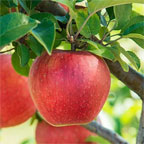- Q.Fire Blight In Pear Tree - Three years ago I planted a bare root Bartlet pear tree. It rooted and has been growing well until this ...
- Q.Why Are My Pears On My Pear Tree Only The Size Of A Grape - Hi I bought a 3 different pear bare root fruit cocktail tree 10 years ago. It has started to grow ...
- Q.How To Treat Rust On Pear Tree ? - ?
- Q.Where Can I Buy D’anjou Pear Tree - I HAVE A LUSCIOUS PEAR TREE, WOULD LIKE A SMALLER D'ANJOU TREE TO POLLUNATE. WILL A DWARF WORK? BEST PLACE ...
- Q.What Are These - These appeared at the base of my potted pear tree, I removed them and they were back in about three ...
- Q.Something Odd On My Pear Tree Leaves. - I found some odd looking attachments under some of my pear tree leaves. Not knowing what they are I have ...
- Q.Pear Leaves Browning - Hello, Mid December in Australia, large brown patches began appearing on two pear trees separated over 3 km on two ...
Q.Fire Blight In Pear Tree
Three years ago I planted a bare root Bartlet pear tree. It rooted and has been growing well until this past late winter spring when Fire Blight began to appear on its leaves. Careful trimming was done to remove the infected branches/leaves. Now new sprouts are appearing near the trunk (about 24 to 36" in length. The leaves look heathly. The overall tree is about 6' tall. The tree appears dormant due the Fire Blight. Question: I've been considering replacing the tree since I understand the Fire Blight remains within the tree. However, since the lower part of the tree has new growth, should I trim the rest of the tree down to that point and take a chance on the blight having not reached the base of the tree?
- A.
I would not allow the lower portion of the tree to grow. Likely, it is not the same pear as the top. Usually, they are grafted to a more vigorous root stock that does not fruit well, or at all.
I would replace the tree, after solarizing the soil. This will get rid of anything lurking in the soil in an expedited manner.
Was this answer useful?10
Q.Why Are My Pears On My Pear Tree Only The Size Of A Grape
Hi I bought a 3 different pear bare root fruit cocktail tree 10 years ago. It has started to grow pears over the last 3 years. They only reach the size of a grape, so last winter I took off 5 ft off the top and thinned out all the branches. Well most of the branches grew all out still the same small grape size fruit. I used 16 16 16 fertilizer before spring since I live in northern Mississippi and 10 10 10 during the growing season. What am I not doing right.
- A.
It could be that the top graft has died, and the rootstock has taken over. Many times, the callery pear root is used. This wild pear rarely exceeds the size of a grape.
https://www.gardeningknowhow.com/ornamental/trees/ornamental-pear/callery-pear-information.htm
https://www.gardeningknowhow.com/ornamental/trees/tgen/what-is-a-graft-collar.htm
Unfortunately, a reverted specimen cannot be brought back without doing some grafting of your own.
https://www.gardeningknowhow.com/ornamental/trees/tgen/grafting-trees-what-is-tree-grafting.htm
Was this answer useful?00 - A.
These articles should help:
https://extension.okstate.edu/fact-sheets/pear-rust.html
https://www.gardeningknowhow.com/edible/fruits/pear/pear-rust-mite-damage.htm
Was this answer useful?00 Q.Where Can I Buy D’anjou Pear Tree
I HAVE A LUSCIOUS PEAR TREE, WOULD LIKE A SMALLER D'ANJOU TREE TO POLLUNATE. WILL A DWARF WORK? BEST PLACE TO BUY IT?
- A.
D'Anjou is considered a pollinator along with Bartlett, Bosc, and Comice. D'Anjou is semi-dwarf. We don't recommend vendors or products, but a reputable tree nursery or garden center should have them.
https://www.gardeningknowhow.com/edible/fruits/pear/care-for-a-danjou-pear-tree.htm
https://www.gardeningknowhow.com/edible/fruits/pear/luscious-pear-tree-care.htm
Was this answer useful?00 Q.What Are These
These appeared at the base of my potted pear tree, I removed them and they were back in about three days
- A.
It's a fungus, but hopefully not armillaria root rot. Here is more:
https://www.gardeningknowhow.com/edible/fruits/pear/treating-pears-with-armillaria-rot.htm
https://www.gardeningknowhow.com/ornamental/fungus-lichen/what-are-fungi.htm
Was this answer useful?00 Q.Something Odd On My Pear Tree Leaves.
I found some odd looking attachments under some of my pear tree leaves. Not knowing what they are I have removed the offending leaves and disposed of them. What are these attachments please?
- A.
I believe this to be one of many caterpillars known as the Stinging Moth Caterpillar (One of several Megalopygidae species). There are many remedies, from predatory insects, to natural methods. I would recommend these. Azadirachtin is one of my personal favorites. This is the active ingredient of Neem oil.
This article will help:
https://www.gardeningknowhow.com/plant-problems/pests/insects/prevent-caterpillars.htm
Was this answer useful?10 Q.Pear Leaves Browning
Hello, Mid December in Australia, large brown patches began appearing on two pear trees separated over 3 km on two properties. Fortnight later, issue has spread. A few sites have photos of the issue, but none present a name for the problem, nor a solution. It is not frost caused, or fire blight. Fruit is not affected...as yet. Thank you.
- A.
This is likely Pear Decline Disease. This is caused by an organism called a phytoplasma. This particular species is carried by a little insect known as the pear psylla.
This cannot be cured, but can be managed. Proper care and insect control, as well as near perfect cleaning of dead materials will ensure a longer lifespan while living with the disease.
Other than that, you will need to get a pear tree with resistance to the disease, or with a root stock that will resist infection.
https://www.gardeningknowhow.com/edible/fruits/pear/pear-decline-phytoplasm.htm
Was this answer useful?10 - A.
Thank you, Bush Doctor, for your prompt and informative response.
I am glad that there is a name to the issue. I haven't applied any compost or fertiliser for about two years and maybe that is the issue with poor nutrition. I’ll set about rectifying that immediately.
Cheers.Was this answer useful?00



